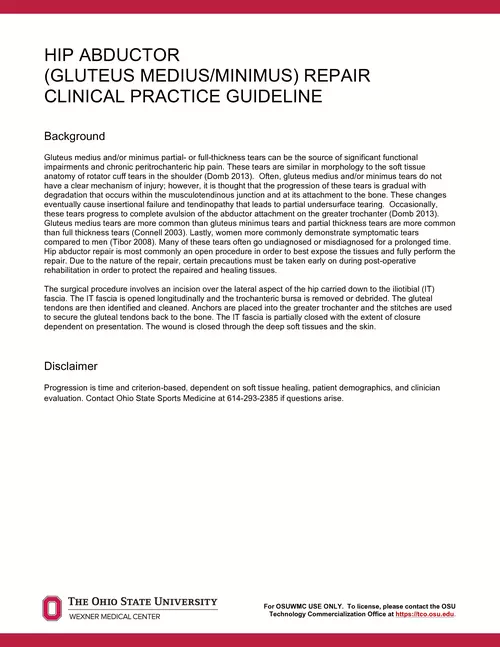
hip abductor (gluteus medius/minimus) repair clinical practice
Gluteus medius and/or minimus partial- or full-thickness tears can be the source of Exercise. ? Gradually progress gluteus medius/minimus strength.
adsPart of the document
For OSUWMC USE ONLY. To license, please contact the OSU Technology Commercialization Office at https://tco.osu.edu. HIP ABDUCTOR (GLUTEUS MEDIUS/MINIMUS) REPAIR CLINICAL PRACTICE GUIDELINE Background Gluteus medius and/or minimus partial- or full-thickness tears can be the source of significant functional impairments and chronic peritrochanteric hip pain. These tears are similar in morphology to the soft tissue anatomy of rotator cuff tears in the shoulder (Domb 2013). Often, gluteus medius and/or minimus tears do not have a clear mechanism of injury; however, it is thought that the progression of these tears is gradual with degradation that occurs within the musculotendinous junction and at its attachment to the bone. These changes eventually cause insertional failure and tendinopathy that leads to partial undersurface tearing. Occasionally, these tears progress to complete avulsion of the abductor attachment on the greater trochanter (Domb 2013). Gluteus medius tears are more common than gluteus minimus tears and partial thickness tears are more common than full thickness tears (Connell 2003). Lastly, women more commonly demonstrate symptomatic tears compared to men (Tibor 2008). Many of these tears often go undiagnosed or misdiagnosed for a prolonged time. Hip abductor repair is most commonly an open procedure in order to best expose the tissues and fully perform the repair. Due to the nature of the repair, certain precautions must be taken early on during post-operative rehabilitation in order to protect the repaired and healing tissues. The surgical procedure involves an incision over the lateral aspect of the hip carried down to the iliotibial (IT) fascia. The IT fascia is opened longitudinally and the trochanteric bursa is removed or debrided. The gluteal tendons are then identified and cleaned. Anchors are placed into the greater trochanter and the stitches are used to secure the gluteal tendons back to the bone. The IT fascia is partially closed with the extent of closure dependent on presentation. The wound is closed through the deep soft tissues and the skin. Disclaimer Progression is time and criterion-based, dependent on soft tissue healing, patient demographics, and clinician evaluation. Contact Ohio State Sports Medicine at 614-293-2385 if questions arise.


